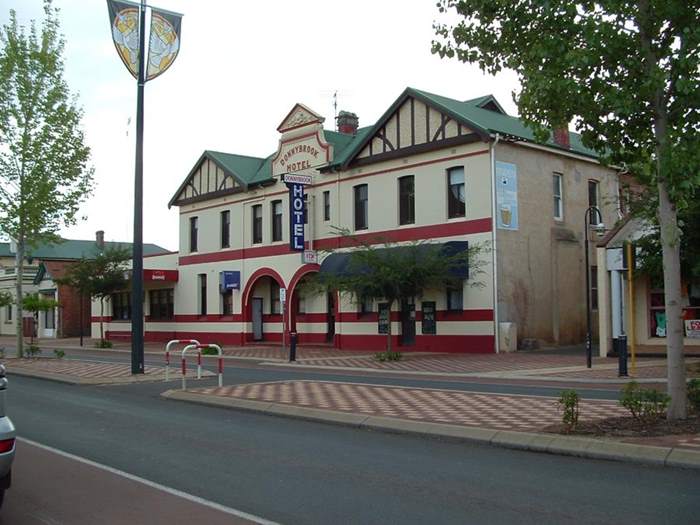DESCRIPTION
Donnybrook seems to be a popular choice for a location name as there are no less than 5 just in Australia. Apart from W.A. there is a Donnybrook
in Queensland, New South Wales, Victoria and South Australia.
Timber, gold, dairy, beef and even stone have been produced in the area over the years. Donnybrook freestone was used in the construction of many
important buildings in W.A. including the Supreme Court, Claremont Teachers College, the chapel at Guildford Grammar school, St. Mary's cathedral,
the General Post Office and the Commonwealth Bank in Forest Place to name just a few. Some of the historic sandstone quarries are now listed on the
State Heritage Register.
Today Donnybrook is a centre for beef, potatoes and fruit growing with apples being among the most prominent with an apple festival now held each Easter.
The area was partly responsible for the development of the Granny Smith apple (but the apple was not first produced there despite the town being trumpeted
as the 'home of the Granny Smith apple'.)
Apples have been grown in the district since the 1890s with George Parke being credited as the first commercial orchardist in the area. The person credited
with first developing the granny smith apple was Mary Ann Smith in 1868.
The Anchor and Hope Inn which dates back to 1845 is listed by the National Trust and is now a private residence.
15km north of Donnybrook is the small town of Boyanup. A local museum houses a collection of vintage cars and an old train. There are also displays of farming
machinery and the theme of the museum is transport. At the time of writing the Leschenault Lady, a Steam Locomotive, has been stripped and is undergoing repairs.
The South-West Rail and Heritage Centre opens once a month and also by appointment.
Donnybrook is a pretty town, very neat and attractive. It is the centre of an expanding fruit growing region and it is worth while stopping at various growers
who put out signs advertising when fruit is in season. The fruit is better quality and cheaper than you will get in supermarkets.
It is not widely known that behind the shops on the main street of Donnybrook is the Preston River. There is a swing bridge to walk across, a first peoples walk trail with a Wagyl Scuplture
and a Donnybrook stone Amphitheatre. As these are not visible from the main road and they are not well signposted, many visitors miss out on seeing them. (Thanks to
Donnybrook Stone and History for sending us this information.
Mighty oaks from little acorns grow
Donnybrook is home to what is reputedly the largest oak tree in Australia. The tree was planted in 1890 by persons unknown and has reached a girth of 5 metres
and a height of 23 metres.
HISTORY
Settlement began in 1842 when 5 Irishman - led by George Nash - and 4 male servants moved into the area and attempted to establish a farm breeding
horses and beef cattle. This was unsuccessful so they tried sheep farming. In this they were even less successful.
One of the original party - James Bessonett - took up land closer to Boyanup but again the venture failed. In 1845 he tried one more
time before giving up and returning to Ireland.
Small scale settlement of the area continued on and off from 1850-1870. Some sources say the town was originally called Irish-town but there is proof that
the name Donnybrook was used as early as 1843.
The 'old tin shed' a.k.a. the Agricultural Hall was constructed in 1896 and the railway came to the area in 1891.
The first person known to have prospected for gold in the area was G.W. Simpson who tried first in 1874 and then again in 1880 without much success.
It is not known at this stage who first found gold in 1897 but Bourke and Richard Hunter are listed as having found gold at Nonneycup Creek in the following year.
Work undertaken by Mr. Modest Maryanski then led to the Donnybrook Goldfields Ltd. Company (circa 1898) being established.
'there is every reason to believe that, as a mining centre, Donnybrook has a great and profitable future ahead of it.'
Twentieth Century Impressions of W.A. 1901
Sadly the gold ran out after just 3 years. Although the gold ran out very quickly, it can be credited with attracting a large number of people to the area and giving
a kick start to the town's growth. Records show a total of 841 ounces of fine gold being produced by the mines and another attempt was made to open the area
up to gold production in 1935 by Laurie and Foster Payne when another 102 ounces were produced. A last attempt to revive the goldfield was made in 1980
but it came to nothing in the end.
The names Irishtown, Minninup, Preston and Donnybrook have all been used at one time or another and just to confuse people the Road Board retained the Preston
moniker until the 1960s. The name Donnybrook was gazetted in 1894.
TALL TALES AND TRUE
A tale of two apples.
The Granny Smith apple (like so many other new varieties of fruit) seems to have been a happy accident with Maria Ann Sherwood-Smith developing
the first apples from an apple core that was thrown away and the seeds then germinating - or so the story goes.
The new variety of apples were first popular in N.S.W. and their arrival in Donnybrook also seems to have come about by chance. A Mr. Chapman was
dealing with a nursery in N.S.W. and as part of a consignment he was sent a couple of the new apples trees to try out.
The trees did well in Donnybrook and the green apples they produced were good for both cooking and eating. The apples were first known locally as Champan's
Late. Cuttings were taken and grafted to other apple trees, the Parke brothers brought in a further 175 trees from N.S.W. and soon the Granny Smith apple
came to dominate apple production in the area.
The apple that was really developed in the Donnybrook area is the less well known Lady Williams. This is a red apple that again seems to have come about by
accident when a seed germinated and came up near a water tank. The tree was almost killed twice - even being pulled out of the ground on one occasion.
The Williams family persisted with the tree and gradually developed a new type of apple from the original sapling.
VIDEO
PROBLEM PLAYING THESE ON FIREFOX?
Turn off Enhanced Tracking Protection
Click the shield icon left of the URL near the top left
Slide Advanced Tracking Protection to OFF
Check out our other VIDEOS
NEW **** CLICKABLE VIDEO MAPS **** NEW
Check out our other VIDEOS
NEW **** CLICKABLE VIDEO MAPS **** NEW
OTHER INFORMATION
ATTRACTIONS
Rotary Lookout, Canoe Course, Glen Mervyn Dam, Bedford's Mill, Museum, Bonsai & Willow Gardens, Willow park, Curiosity Swamp, Kirup Falls,
Glen Karaleea Deer Park, Ironstone Gully Falls
BUILDINGS OF NOTE
Soldiers memorial hall 1919, All saints church 1906, Anchor & Hope Inn 1865, Blackwood Inn 1865.
ELECTORAL ZONES
State : Capel
Federal : Forrest
OTHER INFO.
Postcode : 6239
Local Government : Shire of Donnybrook / Balingup
PHOTOS
Sadly something has disabled these photo sections on our website.
We don't know what it is or how to fix it.
Aplolgies for the inconvenience. We will work on finding a way round it.










